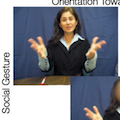Abstract
Understanding the intentions and desires of those around us is vital for adapting to a dynamic social environment. In this paper, a novel event-related functional Magnetic Resonance Imaging (fMRI) paradigm with dynamic and natural stimuli (2 s video clips) was developed to directly examine the neural networks associated with processing of gestures with social intent as compared to nonsocial intent. When comparing social to nonsocial gestures, increased activation in both the mentalizing (or theory of mind) and amygdala networks was found. As a secondary aim, a factor of actor-orientation was included in the paradigm to examine how the neural mechanisms differ with respect to personal engagement during a social interaction versus passively observing an interaction. Activity in the lateral occipital cortex and precentral gyrus was found sensitive to actor-orientation during social interactions. Lastly, by manipulating face-visibility we tested whether facial information alone is the primary driver of neural activation differences observed between social and nonsocial gestures. We discovered that activity in the posterior superior temporal sulcus (pSTS) and fusiform gyrus (FFG) was partially driven by observing facial expressions during social gestures. Altogether, using multiple factors associated with processing of natural social interaction, we conceptually advance our understanding of how social stimuli is processed in the brain and discuss the application of this paradigm to clinical populations where atypical social cognition is manifested as a key symptom.
